Thinking Styles
Thinking styles are segments for measuring value to people.
Measure precisely how your solutions match each thinking style.
And build your experiments based on each thinking style.
Check out the course on Thinking Styles
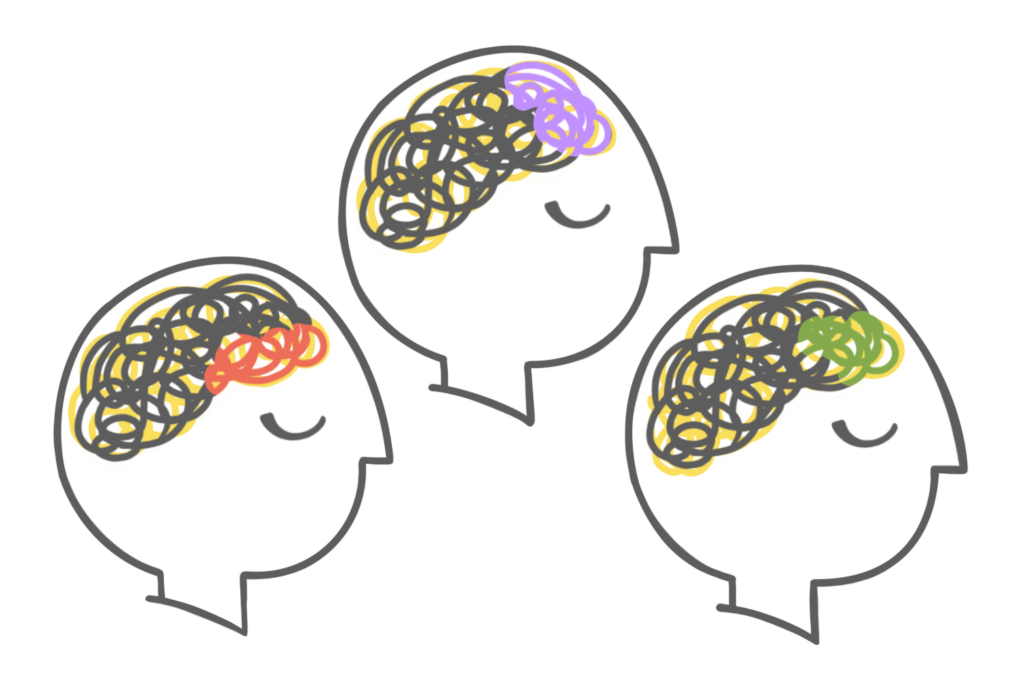
“A style is a way of thinking. It is not an ability, but rather, a preferred way of using the abilities one has. The distinction between style and ability is a crucial one.
Thinking Styles by Robert J. Sternberg, PhD,
– An ability refers to how well someone can do something.
– A style refers to how someone likes to do something.”
p. 8, published 13-Mar-1999
Your org helps people do their thing
People have different ways of approaching something, and thinking styles represent that variety.
A thinking style describes only the differences in how each group of people addresses it. There are still a lot of similarities.
Organizations can support all thinking styles in the same way. But when two thinking styles differ enough, organizations have the opportunity to support them with nuance.
Goal, Intention, or Purpose
The value in thinking styles comes from representing the real complexity of getting something done … something that is long, circular, or ongoing. It also can be used for simple purchase or adoption.
We use more complex phrases to represent the “something” that people are addressing. This shift in framing is important.
Examples:
- Recover a site or platform after it was hacked or attacked by a virus
- Shift skilled employees into new roles
- Handle a near-miss incident
- Take care of my clothing
- Mentor a few people in my area of expertise
Typically, organizations find 2-4 thinking styles per goal
Within a goal, intention, or purpose, there is a bit of variation across people’s mental approaches, but not a lot.
Why look at a person’s goal or intention?
It’s about looking through a new lens that is not about solutions.
By confining the focus, you can see people more clearly. Working at a “personality” level (like a horoscope), you will see behaviors that cross many parts of a person’s life. It makes you generalize too much to add value to your solutions.
Working at a goal or intention level, you can see deeper into cognition. It allows you to create solutions that support people’s various approaches to their goal, creating much more value for them.
For example, a passenger trying to get to their destination might operate under one of the four thinking styles to described here. You can understand that a “Let’s Do This Correctly” passenger whose route got canceled might get anxious about being stranded if staff don’t appear to have a consistent plan.
This person is not a “grumbler” personality who is likely to yell at other drivers in traffic. They are a human in a specific context, and their anxiety got triggered. Teams are able to create support for this human where they are likely to ignore the “grumbler” personality.
Knowing there are “Let’s Do This Correctly” thinking styles among the people at the gate, the airline can make sure their staff help passengers know how things work and what the plan is. Staff can help passengers feel seen. They can get creative with fixes to individual issues. The number of aggressive or abusive interactions from passengers will go down.
Organizations can take an outside-in approach to their solution strategy, instead of focusing internally at solutions they already know. Orgs can build solutions to support humans.
Thinking styles are about a particular thing people are focused on. In this example, the intention is to arrive at the gate to take a long-distance trip.
4 thinking styles – purpose: take a long-distance trip
Let’s Do This Correctly
I know how things could work when done correctly, so that everyone gets their due.
It’s frustrating when not everyone is aware and following the rules.
I expect the staff to have a consistent plan and respond in a human way when things go wrong.
I may get anxious, and I may show my frustration when the airline staff and other flyers are not holding up their end of the bargain.
Positive Experience for Everyone
I recognize we are not in control during air travel, so I try to take it as it comes.
I do what I can to create a positive environment for myself and for others.
I’m likely to go out of my way to help people and treat them well, from fellow passengers to the flight crew, to make a positive impact on their experience.
It’s the right thing to do, plus it might benefit me with good treatment in return.
In the Bubble
I need my flights to be stress free, because flying is a chore.
I might be a routine flyer, afraid of flying, an occasional flyer, or under stress from another part of my life.
I prepare every detail to achieve a serene bubble.
I like to surround myself with people who are relaxed and experienced at the gate and on board. I might strive to avoid disturbing others, lest I give them any stress.
I keep entertained or maybe distracted from my anxiety.
Use My Time Wisely
Time is of the essence. I need to keep moving to fit everything into the day.
When things go wrong, I am proactive. I make decisions about how to keep moving and working given what is happening.
I expect the airline staff to offer me information and potential options so I can do my calculus with all the variables.
I want a space to do my work (whether it’s knitting or a presentation deck) at the gate or the lounge, and on board, so I can get stuff done. When space is not available, I may choose to press for it.
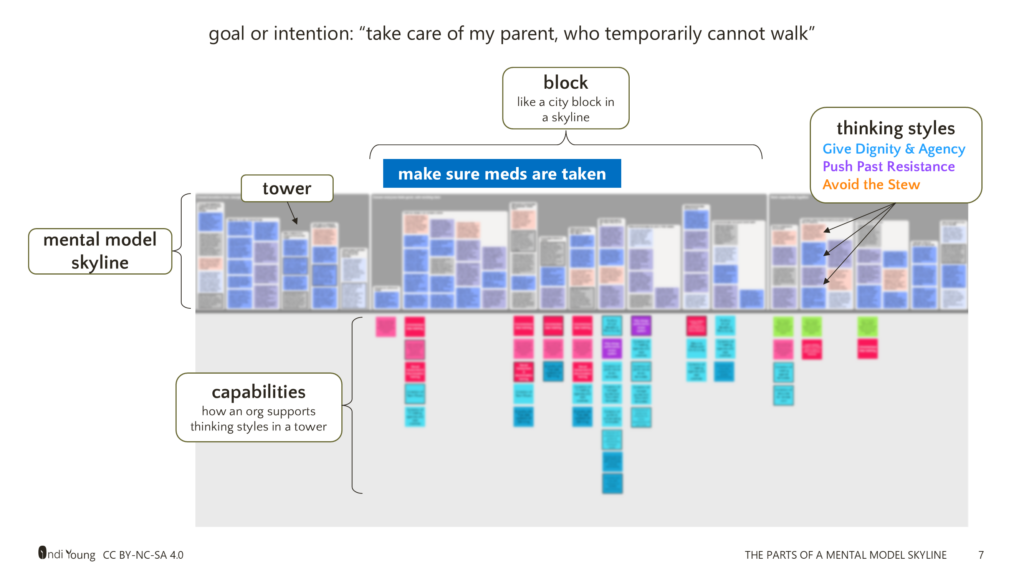
How do organizations use Thinking Styles?
An organization that is aware of the set of thinking styles they can support is able to offer something that others do not—a service that allows for the marvelous human mind.
Thinking Styles are more actionable and precise than roles, personas, or demographics.
Strategic discussions allow leadership to consider how trends, technology, and competition affect which direction the organization will go.
The skyline provides a framework to map these together with how people define their own success, which reveals new opportunities to help people succeed.
Check out the course on Thinking Styles
1. Innovate with a whole new lens
Thinking styles and mental model skylines reveal possibility spaces from the point-of-view of what people grapple with to achieve success.
Mental model skylines help organizations look at people without focusing on tools and processes. It is a new lens on a broader landscape. This lens helps leadership question accepted assumptions about people, because their beliefs about their solution are not part of the picture.
You can find examples in Indi’s talks and essays
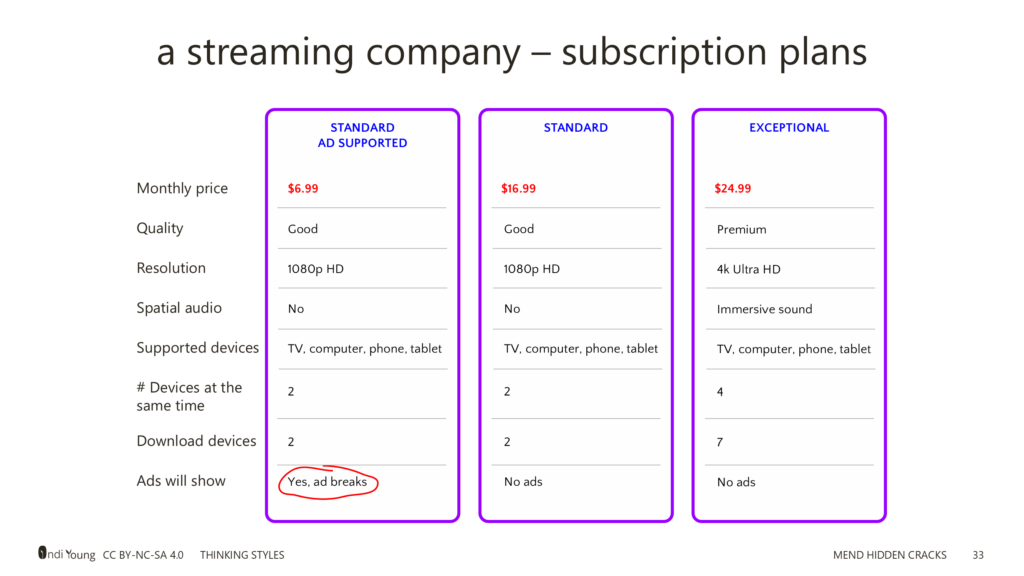

Orgs can even address non-functional parts of their solutions, like pricing.
2. Measure benefits to people’s outcomes
What gets measured gets managed. Currently, organizations measure their progress in two categories. Introducing mental model skylines and thinking styles provides a third category of measurement–people’s success at their own goals or intentions.
- Outcomes for the organization OKR’s and their KPI’s; how an organization is doing in terms of process, profit, brand, adoption rates, etc.
- Outcomes of the solution How smooth is it for people to use the solution? e.g., evaluative research, satisfaction studies, churn rate, net promoter score
- (currently missing) Outcomes for people Are people successful in addressing their larger goal or intention in a better way? That matches their thinking style?
By adding outcomes for people, organizations see team productivity and creative motivation skyrocket. Product managers get energized by seeing these scores improve across product cycles. And people’s outcomes benefit.
Measurements like these give leadership more knowledge to help prioritize where to focus as and some additional advantages:
- Pivot earlier: When a hypothesis is incorrect, leadership can catch it earlier using the model and shift to another prioritized opportunity.
- Accelerate time-to-value: Launching a well-defined solution helps ensure market success by capturing the market earlier.
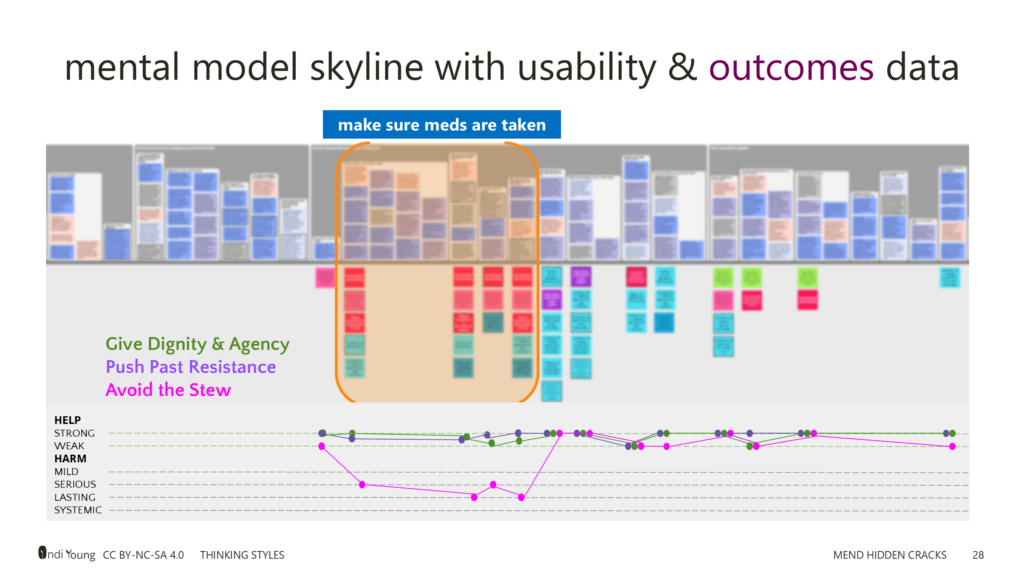
Product teams check the viability of solutions through evaluative research. They recruit participants by their thinking style. A score for each thinking style can be graphed beneath the relevant section.
Layering other quantitative data on a mental model skyline puts all the knowledge in one visualization.
Gain attention in the market by creating better outcomes for thinking styles that are ignored.
3. Tell opportunity stories
Internally, communicating ideas with stories helps people collaborate across an organization. This is why journey-maps are popular.
- Thinking styles gives these stories underpinnings that clarify specific opportunities for the organization.
- Opportunity stories communicate how the organization’s focus is tied to the opportunity in the skyline.
Humans have been inventing stories for 10,000 years. Stories are a memorable way to convey new ideas quickly, with the depth and complexity of thinking styles.

Cast of characters in a TV series
Here is where you create a cast of characters for your org to work with over the years. You describe each character, give them names, backstories, appearances, and personalities. You create a world for them to live in, and connections between them so they know each other.
Then you write episodes, one for each priority combination of opportunity and thinking style that your team is exploring in the mental model skyline. Each episode allows the characters to interact with each other in regard to their goal or intention.
A character wears a thinking style like a hat within an episode. Thinking styles are not personalities, so the character’s thinking style might change from episode to episode, depending on the context they are in.
Each of the episodes conveys ideas for the organization to discuss.
Bonus:
You have a chance to show decision-makers how people with different demographics can have the same thinking style toward one goal or intention.
Likewise, you can demonstrate how people with the same demographics can have different thinking styles toward one goal or intention
3.a – Example opportunity Story
The headquarters team at a regional fast-casual lunch chain (22 stores) wants to improve their mobile ordering experience; this is their focus. From last year’s knowledge-building work, they already have a mental model skyline and thinking styles, focused on people’s intent to “decide what to grab for a workday lunch.”
The team is focused on “pre-order my food,” where they see an opportunity to support the Keep It Different thinking style.
To keep the org focused on people, not on their restaurants, they tell the story about a burrito spot instead.
The characters: Kam (who gets teased for being consistently “Keep It Different”), Sal (this week wants to “Stick with My Favorites”), Alex (this week wishing for “A Place to Linger”).
The opportunity story: There is a group of friends with similar demographics (age, life situation, professional field) who work at different places in the same city. They meet every Friday for lunch to hang out. Friday around 11am they group text each other with suggestions where to meet. They’ve got several favorite places, and the group agrees on a burrito spot before Kam has a chance to respond.
Kam: noooo, I had a burrito last night!
Sal: sorry Kam, gotta leave by 1 cuz inspection
Sal: this place closest to my job site
Kam: I go find something on my own
Alex: Aw. Kam, join us! Need to catch up!
Sal: they have other stuff
Alex: Fried shrimp special! Or that soup
Kam: okay okay see you
Alex: you might have to order there
thinking styles for “decide what to grab for a workday lunch”
Stick With My Favorites
I’ve got my favorite foods, and I rotate through them over the weeks. I already settled on my choices, and how to customize them.
Once in a while I might be open to trying something new, when my companions recommend something.
I already chose my places, where the employees have a decent attitude.
Keep It Different
I’ll usually look for something different to order, and I’m happy to find a new place to try.
When there’s nothing new, I go with my usuals, but I never repeat the same food twice in a row.
Food variety is one thing I can be in charge of during the work week.
A Place to Linger
I like to go somewhere with a comfy, clean atmosphere that also has a little style. Did I say clean? It has to be clean—and the air cannot be stale.
I love to linger over my meals, either by myself or with friends. I sometimes chat with friends or other folks there.
I’ve got my usual orders at the places I go, but I’m open to something new if I see it.
In between the lines:
- For many people, choosing a restaurant is the same as choosing the food.
- Lunch specials are sometimes the deciding factor, but only appear at the restaurant site itself.
- People with the same demographic can exhibit different thinking styles for the same goal or intention.
After the story, the team shows their idea for online ordering that will let Kam order ahead of time, quickly.
- (existing) A section called “The Usual,” with the customer’s past orders, including customizations.
- A new section called “The Un-Usual” shows the lunch special, anything a customer ordered only once before (with a “delete” option), and three other suggestions.
About roles, demographics & personalities
Thinking Styles are free of demographics.
Instead of assigning behaviors by demographic or role, a team can see what’s actually going on in people’s minds and craft the outcomes of solutions in a tailored way, helping people feel seen.
Demographics don’t cause cognition
Ordinarily, demographics don’t cause inner thinking, emotional reactions, or personal rules, except when a person faces treatment that is unjust.
Some of the characters you create will be able to convey thinking, emotional reactions, and personal rules that have built up from unjust experiences.
A person’s thinking style can shift
A person might address their goal or intention with different thinking styles in different contexts.
For example, if you are taking care of your parent while they temporarily cannot walk, you may shift through several thinking styles across the course of many weeks.
If you are a passenger, you may follow one thinking style when you travel on business, but another when you travel with a toddler.
Your thinking style might shift more slowly, based on life events. Like you may approach saving for the future differently after becoming a parent or losing a family member.
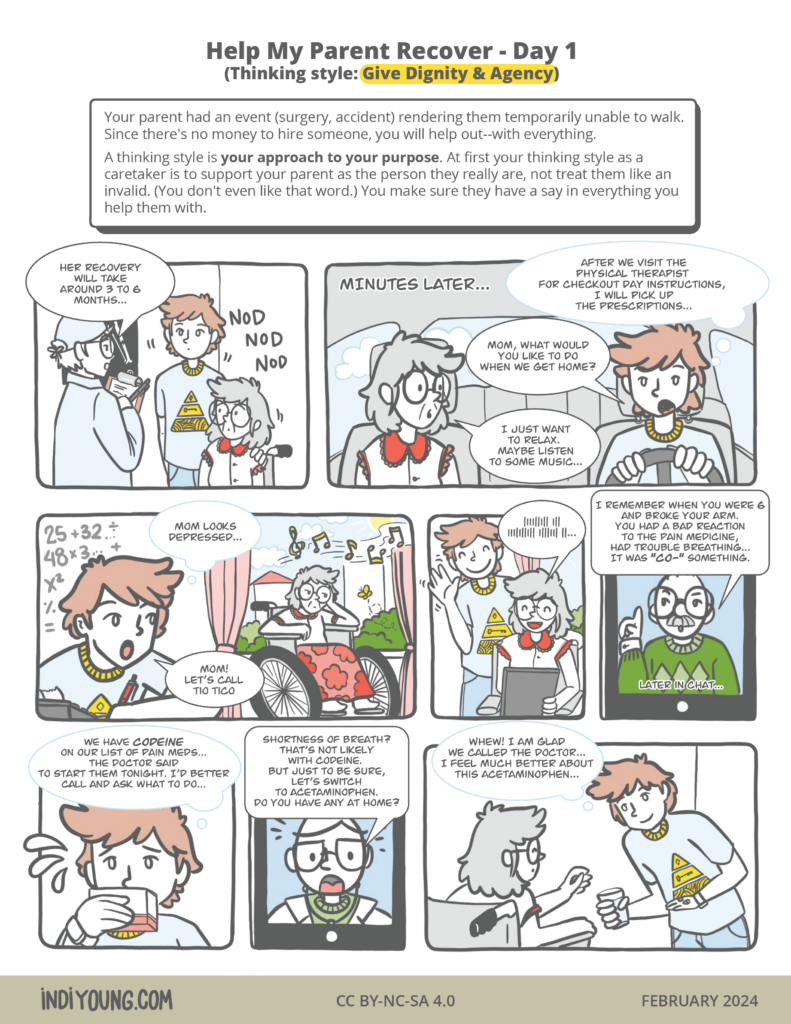
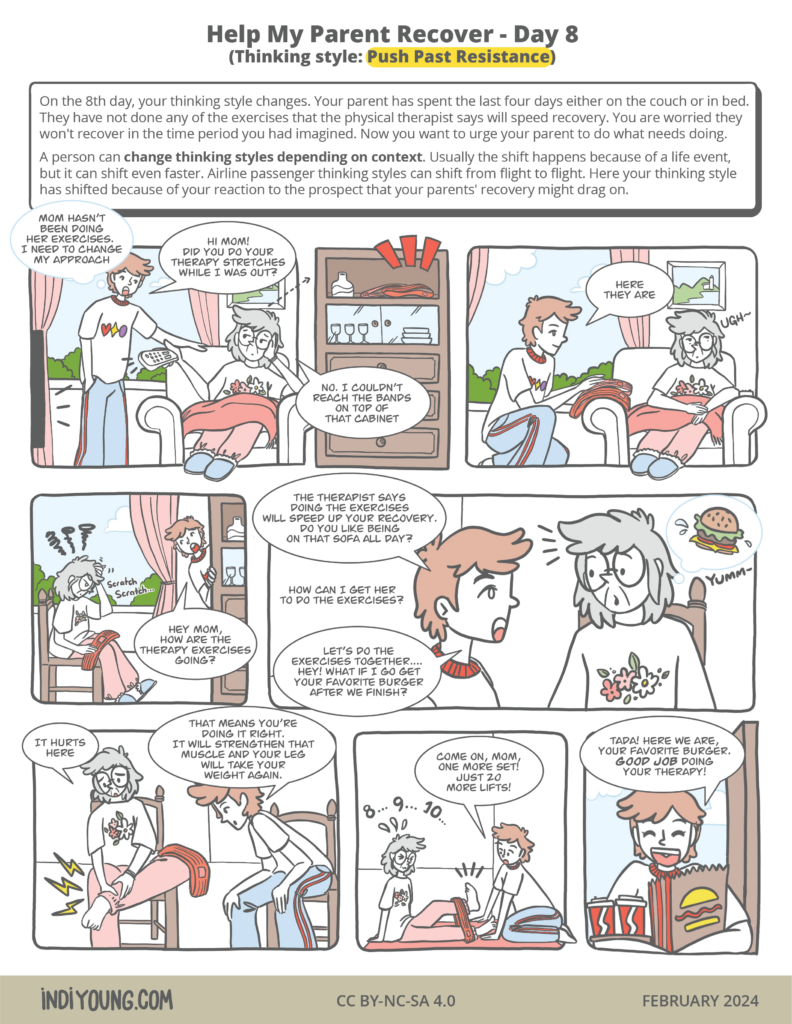
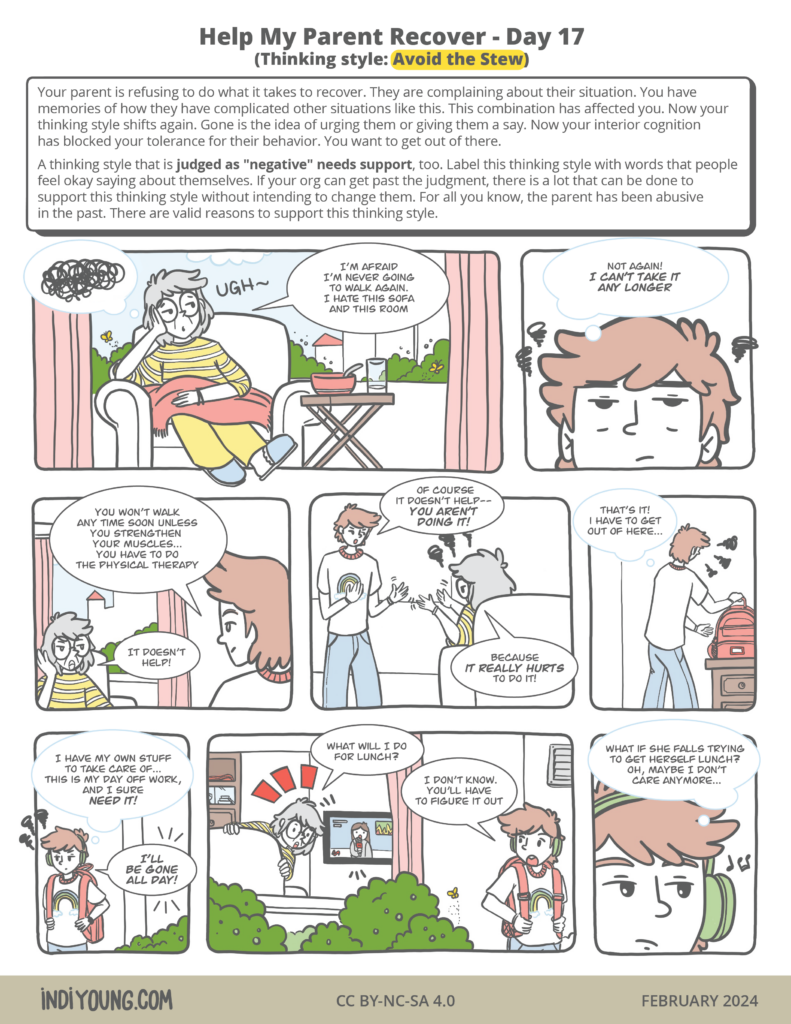
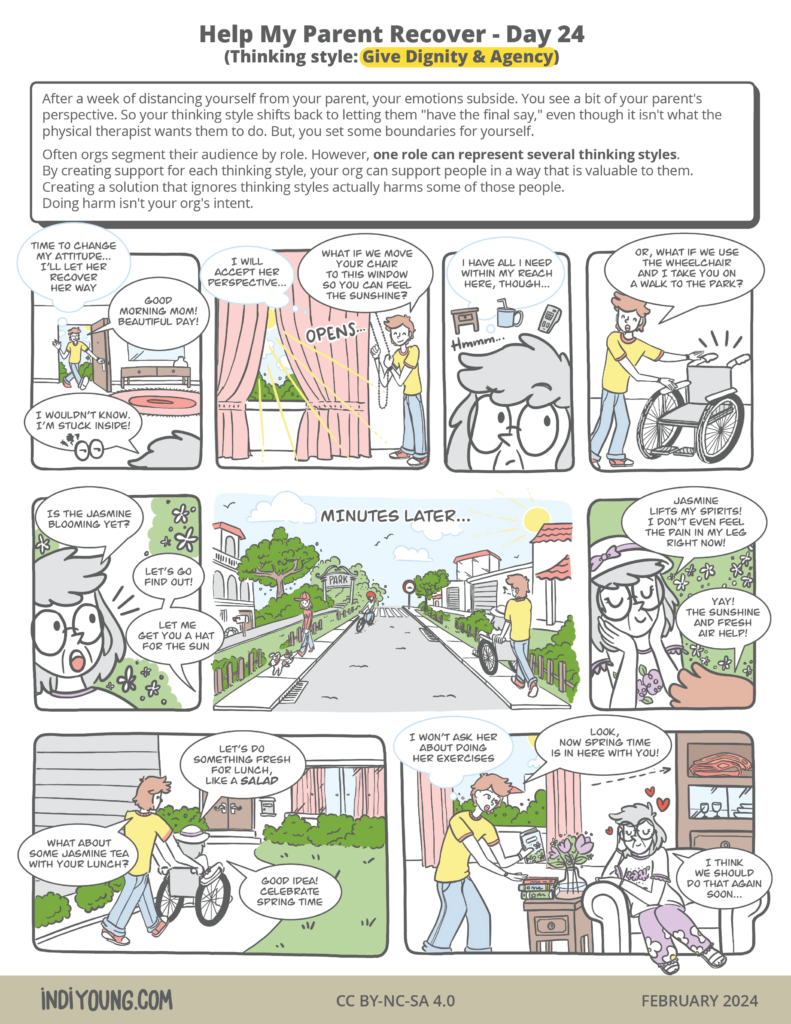
How do you make Thinking Styles?
Thinking style groups represent the variety in people’s approaches as they addressed their goal or intention. To resist bias and assumptions, this knowledge comes from research using listening sessions.
The data is gathered from memory of past cognition. To get at the level of cognitive empathy needed to find thinking styles, use listening sessions, which are set up to allow patterns to emerge.
Cognition includes:
- inner thinking
- emotional reactions
- personal rules
Using an empirical qualitative data method, a team can see patterns emerge. Learn how, or ask us to do a study for you.
Check out the course on making & using Thinking Styles
